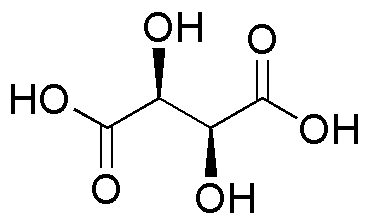D(-)-Tartaric acid is widely utilized in research focused on:
- Food and Beverage Industry: It acts as a stabilizing agent in cream of tartar, which is crucial for baking and winemaking, helping to maintain the desired texture and flavor of products.
- Pharmaceuticals: Used as an excipient in drug formulations, it enhances the solubility and bioavailability of active ingredients, improving the effectiveness of medications.
- Cosmetics: Its natural exfoliating properties make it a popular ingredient in skincare products, helping to remove dead skin cells and promote a smoother complexion.
- Analytical Chemistry: Employed as a chiral resolving agent in chromatography, it aids in the separation of enantiomers, which is essential for the development of enantiomerically pure compounds.
- Biotechnology: Utilized in various biochemical assays and as a buffer in biological experiments, it helps maintain pH stability, which is critical for accurate results.
General Information
Properties
Safety and Regulations
Applications
D(-)-Tartaric acid is widely utilized in research focused on:
- Food and Beverage Industry: It acts as a stabilizing agent in cream of tartar, which is crucial for baking and winemaking, helping to maintain the desired texture and flavor of products.
- Pharmaceuticals: Used as an excipient in drug formulations, it enhances the solubility and bioavailability of active ingredients, improving the effectiveness of medications.
- Cosmetics: Its natural exfoliating properties make it a popular ingredient in skincare products, helping to remove dead skin cells and promote a smoother complexion.
- Analytical Chemistry: Employed as a chiral resolving agent in chromatography, it aids in the separation of enantiomers, which is essential for the development of enantiomerically pure compounds.
- Biotechnology: Utilized in various biochemical assays and as a buffer in biological experiments, it helps maintain pH stability, which is critical for accurate results.
Documents
Safety Data Sheets (SDS)
The SDS provides comprehensive safety information on handling, storage, and disposal of the product.
Product Specification (PS)
The PS provides a comprehensive breakdown of the product’s properties, including chemical composition, physical state, purity, and storage requirements. It also details acceptable quality ranges and the product's intended applications.
Certificates of Analysis (COA)
Search for Certificates of Analysis (COA) by entering the products Lot Number. Lot and Batch Numbers can be found on a product’s label following the words ‘Lot’ or ‘Batch’.
*Catalog Number
*Lot Number
Certificates Of Origin (COO)
This COO confirms the country where the product was manufactured, and also details the materials and components used in it and whether it is derived from natural, synthetic, or other specific sources. This certificate may be required for customs, trade, and regulatory compliance.
*Catalog Number
*Lot Number
Safety Data Sheets (SDS)
The SDS provides comprehensive safety information on handling, storage, and disposal of the product.
DownloadProduct Specification (PS)
The PS provides a comprehensive breakdown of the product’s properties, including chemical composition, physical state, purity, and storage requirements. It also details acceptable quality ranges and the product's intended applications.
DownloadCertificates of Analysis (COA)
Search for Certificates of Analysis (COA) by entering the products Lot Number. Lot and Batch Numbers can be found on a product’s label following the words ‘Lot’ or ‘Batch’.
*Catalog Number
*Lot Number
Certificates Of Origin (COO)
This COO confirms the country where the product was manufactured, and also details the materials and components used in it and whether it is derived from natural, synthetic, or other specific sources. This certificate may be required for customs, trade, and regulatory compliance.


